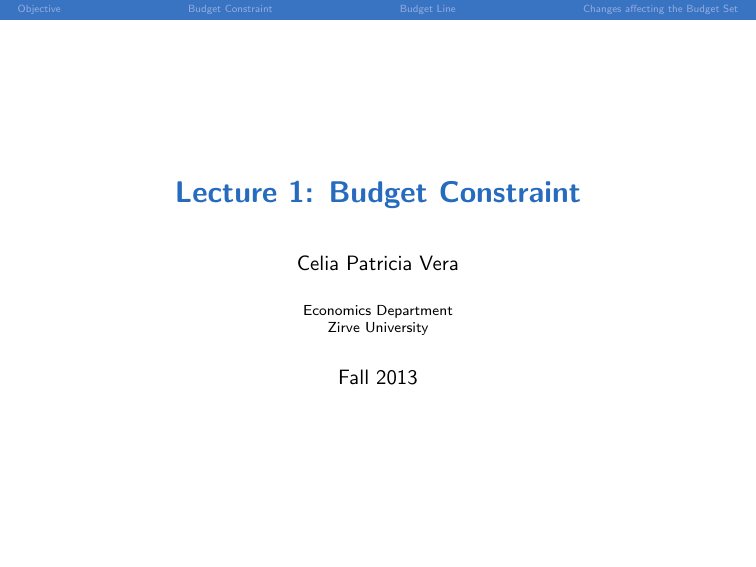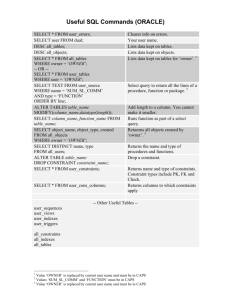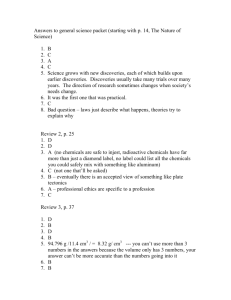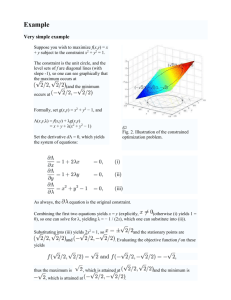Lecture 1: Budget Constraint
advertisement

Objective Budget Constraint Budget Line Lecture 1: Budget Constraint Celia Patricia Vera Economics Department Zirve University Fall 2013 Changes affecting the Budget Set Objective Budget Constraint Budget Line Changes affecting the Budget Set Objective I Consumers choose the best bundle of goods they can afford. I In this lecture, we will focus on “can afford.” I Next lecture we will discuss what “the best bundle” means. Objective Budget Constraint Budget Line Changes affecting the Budget Set Budget Constraint I Consumption choice set: Collection of all consumption choices available to the consumer. I Let’s assume that there are only two goods in this set: good 1 and good 2. I Consumption bundle: The amount of good 1 and good 2 that the consumer chooses to consume, (x1 , x2 ). x1 : quantity of good 1. x2 : quantity of good 2. I The consumer observes the price of the goods (p1 and p2 ) and knows the amount of money he can spend (m). Objective Budget Constraint Budget Line Changes affecting the Budget Set Budget Constraint I The amount of money spent on the two goods should not exceed the total amount of money the consumer has. I The Budget Constraint can be written as: p1 x1 + p2 x2 ≤ m I Budget Set: The consumer affordable consumption bundles, those that do not cost more than m. I For instance, if p1 = 2, p2 = 3 and m = 30, which of the following consumption choices belong to the budget set? I (x1 , x2 ) = (5, 6) I (x1 , x2 ) = (3, 8) I (x1 , x2 ) = (7, 2) I (x1 , x2 ) = (6, 7) Objective Budget Constraint Budget Line Changes affecting the Budget Set Budget Line I Budget Line: The set of bundles that cost exactly m and thus satisfy the following equation: p1 x1 + p2 x2 = m I In the last example, only (x1 , x2 ) = (3, 8) is in the budget line. Objective Budget Constraint Budget Line Changes affecting the Budget Set Budget Line p1 x1 + p2 x2 = m x2 = m p1 − x1 p2 p2 I The vertical intercept is the quantity of x2 the consumer would buy if all income was spent on x2 (x1 = 0). I The horizontal intercept is the quantity of x1 the consumer would buy if all income was spent on x1 (x2 = 0). Objective Budget Constraint Budget Line Changes affecting the Budget Set Budget Set I A: Inside Budget Line, affordable. I B: In the Budget Line, just affordable. I C: Outside the Budget Line, not affordable. Objective Budget Constraint Budget Line Changes affecting the Budget Set Budget line slope Recall that x2 = m p1 − x1 p2 p2 I Then, the slope of the budget line is − pp12 . I Slope measures the rate at which the market is willing to substitute good 1 for good 2. I It measures also the opportunity cost of consuming good 1. In order to consume more of good 1 you have to give up some consumption of good 2. I The opportunity cost of consuming one more unit of good 1 is p1 /p2 units of good 2 foregone. Objective Budget Constraint Budget Line Changes affecting the Budget Set Budget line slope I Let the bundle consumed (x1 , x2 ) be located in the Budget Line, so it satisfies: p1 x1 + p2 x2 = m I Suppose the consumer is going to increase her consumption of good 1 by ∆x1 . Now he consumes x1 + ∆x1 . How much will her consumption of good 2 have to change (∆x2 ) in order to satisfy her budget constraint? I The new bundle should satisfy: p1 (x1 + ∆x1 ) + p2 (x2 + ∆x2 ) = m Objective Budget Constraint Budget Line Changes affecting the Budget Set Budget line slope I Subtract the first equation from the second one: p1 x1 + p1 ∆x1 + p2 x2 + p2 ∆x2 − p1 x1 − p2 x2 = m − m p1 ∆x1 + p2 ∆x2 = 0 p1 ∆x2 = − = slope of the budget line ∆x1 p2 p1 ∆x2 = − ∆x1 p2 I Then, if the consumer wants to increase her consumption of good 1, she has to decrease her consumption of good 2 and vice versa in order to afford this change. Objective Budget Constraint Change in income Budget Line Changes affecting the Budget Set Objective Budget Constraint Budget Line Changes affecting the Budget Set Changes of p1 A change of p1 shifts the budget line. It also changes the slope and the horizontal intercept. Objective Budget Constraint Budget Line Changes affecting the Budget Set Change of p2 A change of p2 shifts the budget line. It also changes the slope and the vertical intercept. Objective Budget Constraint Budget Line Changes affecting the Budget Set Income and prices increase in the same proportion When income and prices increase in the same proportion, the Budget Line does not change. P2 m P1 Objective Budget Constraint Budget Line Changes affecting the Budget Set BC Example Suppose Jody has 10 each week to spend in hamburgers and candy bars. Each hamburger costs 2, whereas each candy bar costs 1. I Write down the equation of the Budget Constraint. x1 = hamburgers, p1 = 2, x2 = candy bars, p2 = 1 m = p1 x1 + p2 x2 10 = 2x1 + x2 I If Jody devoted all her income to hamburgers, how many could she buy? x2 = 0, x1 =? 10 = 2x1 , x1 = 5 I If Jody devoted all her income to candy bars, how many could she buy? x1 = 0, x2 =? 10 = x2 I What is the opportunity cost of buying 1 hamburger? Jody can buy one hamburger or 2 candies, then the OC of buying one hamburgers is two candy bars. OC= pp12 = 2 Objective Budget Constraint Budget Line Changes affecting the Budget Set Quantity Tax I The consumer has to pay a certain amount to the government for each unit of the good he purchases. I We pay about 15 cents a gallon as a federal gasoline tax. I A quantity tax of t dollars per unit of good 1 changes the price of good 1 from p1 to p1 + t. I From the viewpoint of the consumer the tax is just like a higher price. I This implies that the budget set is affected by the quantity tax in the same way as by an increase in prices (budget line becomes steeper). Objective Budget Constraint Budget Line Changes affecting the Budget Set Value tax (Ad valorem) Tax I I This is a tax on the value -the price- of a good and it is usually expressed in percentage terms. If good 1 has a price of p1 but is subject to a sales tax at a rate τ, then the actual price facing the consumer is (1 + τ)p1 . I If the sales tax is 6 percent, then a good that is priced at 1 will actually cost 1.06. I We will focus on the case of a uniform ad valorem tax, when both goods are affected by an ad valorem tax of τ. Then, prices become ((1 + τ)p1 , (1 + τ)p2 )). I The new budget line is (1 + τ)p1 x1 + (1 + τ)p2 x2 = m p1 x1 + p2 x2 = I m 1+τ The effect of a uniform value tax in the budget line is the same than reducing m the income since 1+ τ < m. Objective Budget Constraint Budget Line Changes affecting the Budget Set Quantity subsidy I The government grants a sum of money to the consumer that depends on the amount of the good purchased. I If the subsidy is s dollars per unit of consumption of good 1, then from the viewpoint of the consumer, the price of good 1 would be p1 − s. This would therefore make the budget line flatter, the same effect that a reduction of p1 . I Objective Budget Constraint Budget Line Changes affecting the Budget Set Ad valorem subsidy I : It is a subsidy based on the price of the good being subsidized. I If the price of good 1 is p1 and good 1 is subject to and ad valorem subsidy at rate δ , then the actual price of good 1 facing the consumer is (1 − δ )p1 . I In the case of a uniform ad valorem subsidy at rate δ , prices become ((1 − δ )p1 , (1 − δ )p2 )). I The new budget line is (1 − δ )p1 x1 + (1 − δ )p2 x2 = m p1 x1 + p2 x2 = m 1−δ I The effect of a uniform value subsidy in the budget line is the same than m increasing the income since 1−δ > m. I A tax increases the price of the consumer, and a subsidy decreases it. Objective Budget Constraint Budget Line Changes affecting the Budget Set Lump-sum tax or subsidy I In the case of a lump-sum tax, the government takes away some fixed amount of money, regardless of the individual’s behavior. I The budget line of a consumer will shift inward because his money income has been reduced. In the case of a lump-sum subsidy,the government gives some amount of money to consumers. The budget line will shift outward. I Objective Budget Constraint Budget Line Changes affecting the Budget Set Rationing constraints I I The level of consumption of some good is fixed to be no larger than some amount. If the good 1 were rationed, it means that no more than x 1 could be consumed by a given consumer.








